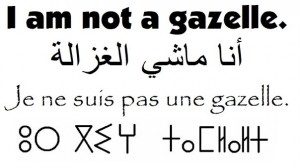 You’re probably wondering what a gazelle has to do with culture, right?! Melibee’s Katy Rosenbaum tackles an important subject for the sojouner – cultural perspective – and explains what this beautiful creature has to do with a very teachable moment. Her story from Morocco reminds us that things are not always as they seem!
You’re probably wondering what a gazelle has to do with culture, right?! Melibee’s Katy Rosenbaum tackles an important subject for the sojouner – cultural perspective – and explains what this beautiful creature has to do with a very teachable moment. Her story from Morocco reminds us that things are not always as they seem!
“Ca va, la gazelle?”
Most women who have spent more than a few days in Morocco have probably heard this catcall on the street.
How are you, gazelle?
To someone coming from another culture, these catcalls might evoke a variety of reactions: anger, offense, annoyance, feeling objectified, feeling threatened, or even flattery. For me, my relationship with my reaction to these catcalls went through several stages during my four years in Morocco, ultimately illustrating several ways to take cultural challenges and make them into true learning experiences.
Among my Peace Corps colleagues, this pattern of young men calling out one-liners as we walked by on the street became a hot topic of debate, sparking many editorials in our internal newsletters and controversial arguments at get-togethers. Most– though not all– of us said that this behavior made us uncomfortable. When I spoke to other American women who were experiencing the same thing, we talked about what specifically evoked these reactions:
– Being the target of a catcall in general, and especially being compared to a “gazelle” or being called beautiful left some of us feeling objectified and occasionally unsafe.
– At times, the catcalls crossed the line into sexual harassment and feeling not simply objectified but sexually objectified.
– Some of us felt that we were being singled out for being visibly American or foreign, and we assumed that this was because of the stereotype that media often perpetuates of the “loose American/foreign women.”
On a deeper level, there was a feeling of conflict and that ubiquitous question of cultural relativism versus universalism: at what point is it our responsibility to change our behavior to conform to the norms of the society? At what point is it a question of human dignity? Did we, as foreigners, need to integrate more? Were we being offensive by our dress or behaviors? Or is this getting into that tricky territory of not compromising our own identity? After all, there is a perception that in some cultures, women should be modest to curtail mens’ sexuality. The conflict of wanting to be respectful but also not wanting to have to compromise too much is an underlying factor to some people’s discomfort with these catcalls.
During my first few years, I’d ask Moroccans about why some men would make these comments, but looking back, it was always tinged with a bit of defensiveness or anger. I thought I was asking and trying to learn, but looking back, I recognize that I was not neutral in these discussions. My tone, my word choice, and my attitude was loaded with some of those feelings that I had, which made a charged situation where people probably did not feel comfortable being totally honest in their responses.
The responses I received in these conversations were fairly similar and superficial: men overwhelmingly said that it was a question of education level. They, themselves would never call out to women on the street because they were “raised right,” but boys that don’t know any better do it to feel good about themselves or have fun.
A few had other responses. One of the colleagues I was assigned to work with in the Peace Corps kept calling me a “gazelle.” He was married, and I didn’t feel anything else from that interaction, but it still bothered me. When I asked him about it, he said that his wife loves it when he calls her a gazelle, and that he saw me as his sister– it’s fine and not at all inappropriate for him to call his sister a gazelle. That being said, when he knew it bothered me, he stopped. He saw it as a complement, and was genuinely confused at my negative reaction.
This fed into my beliefs and reactions: I continued to feel annoyed, bothered, objectified, and singled out for being “foreign.”
I remember the first time that my perception started changing: I had gotten to know a group of youth volunteers at a community development association. They were all young men in their late teens or early twenties that were working to improve the area that they lived in and volunteered their time to tutor local youth, coach sports teams, or work on neighborhood projects. Because of the trust I had with them, I asked them about it over coffee one day– but without defensiveness and with genuine curiosity.
One of them answered my question with a question: “How do you meet your future spouse in the US?”
I responded with everything I could come up with: at school, through mutual friends, through work, through the internet, while going out and socializing. He smiled at me and explained that in most of Morocco, traditionally, there are fewer opportunities to meet people of the opposite sex. In some ways, dating is still taboo, though things are changing and in certain circles it is acceptable.
“Everyone,” he said, “everyone knows at least someone who met his future wife through saying something to her on the street.”
It was not what I expected to hear. Because of the historical separation of men and women and the way that it has changed but still remains in more nuanced forms today, it can be difficult to find a spouse. Some women are flattered with the catcalls and take it as an invitation to make contact with a potential partner– a sort of speed-dating on the street. They might stop for a few minutes to chat, and exchange phone numbers, leading to a dating-by-text-message or dating-by-phone relationship that may or may not end up in a serious relationship or marriage.
This is not always the case: with the diversity within Morocco, there are probably as many reactions to this behavior as there are people in the country. However, I was surprised to realize that there are some Moroccan women who have the same reaction that I do, but also women who see it as an opportunity for connection and even the chance to meet a potential life partner.
I was dumbfounded.
What an “aha!” moment– and what a fascinating view into the complexities of understanding the diversity of culture. From my framework and point of view, it was nearly impossible to think of this behavior as anything but negative, and my attitude when talking about it previously made it easier for people to agree with me. By opening up and asking neutrally with trusted friends, I was suddenly taken out of that framework and able to see the situation from a different light.
Not only was this an interesting glimpse into the diversity of thoughts and attitudes within a culture, but it also provided a window to myself as traveler or as an outsider trying to make sense of the culture I was living in. I jumped to conclusions, even after years of being in Morocco. I assumed that the behavior was based on stereotypes of Americans, I assumed that it was always sexual objectification as the intent, and I tended to always jump to the most negative conclusions. At times, certainly, those were true, but not always.
What rang loud and clear is how important it is to find people you trust to ask about cultural phenomenon that might be upsetting or puzzling, to enter into these conversations while acknowledging your feelings but also trying to remain neutral, and understanding the diversity of thought and behavior within a culture.
Some suggestions while traveling, working, or studying abroad might include:
1. Don’t be afraid to find people in the host culture that are open-minded and that you can build a trusting relationship with who you can ask about the things that make you uncomfortable. Whether this is staff on your program, peers, people from the host country who have spent time in the US, or just a really good friend, people are willing to have those hard conversations or explain perceptions if you are willing to share and ask.
2. If possible, ask people from different walks of life in your host country about these cultural happenings– chances are the diversity of opinions will give you a more complete understanding. Don’t take one person’s opinions at face value as truth for the whole culture.
3. Check your attitude and how you are coming across when you talk about this: it’s easy to come across as upset, and people might not feel like they can be honest if this is the case. If you are emotional or really bothered in the moment, it might make sense to give it a few hours or a few days before talking it through with someone who might feel the need to be defensive if they perceive you are upset.
For faculty and staff interacting with students or volunteers abroad:
1. Listen to those “culture shock” situations that your students are going through and work to make them a point of growth and understanding rather than simply moments of frustration. Encourage students to find trusted host country peers to ask about these situations, or ask questions that help see things from a different perspective. If it’s something that comes up with several students, it might be beneficial to put together a panel of people from different walks of life to talk about these issues. This might involve a scheduled session a few days or weeks into the program that asks participants to share or reflect on the hardest moments for them and then a second session with host country nationals to explore these situations.
2. Create experiences for students or volunteers to be able to meet a wide range of host country individuals: “language partners” from a university, a visit to a retirement home, a visit to a rural location and discussion with a family there, or informal “tea talks” or “coffee hours” might afford participants the opportunity to connect or interact with people that provide a different perspective both in general as well as to certain cultural challenges they might be facing. Encourage students to write down cultural questions that they ask you as faculty or staff, then bring them up in front of these various groups so students can gain exposure to a variety of viewpoints.
3. Integration sessions can be crucial: by checking in with students or volunteers who are experiencing emotional reactions to cultural differences, using active listening, creating a safe environment for students to share, and helping them through these moments can be important.
4. Acknowledge moments that might be an introduction to discussion about cultural relativism versus universalism, and be prepared to support and challenge students to consider this dichotomy and how to navigate tricky situations while keeping an open mind.
Most people experience some struggles when immersed in a different culture. It is crucial to be able to take these hard moments and acknowledge that with the right  attitude and willingness to explore, the processing of these moments can become a catalyst for self-awareness, personal development, and a way to gain a deeper understanding of cultural nuances rather than simply a stress-producing challenge.
attitude and willingness to explore, the processing of these moments can become a catalyst for self-awareness, personal development, and a way to gain a deeper understanding of cultural nuances rather than simply a stress-producing challenge.
What other ways have you used to process moments of challenge or culture shock into a deeper understanding? Are there tools for faculty or staff that you would recommend? For travelers or students? Feel free to share your experiences or advice in the comments!
 About the Author: Kathryn (Katy) Rosenbaum’s love of exploring cultures and language stemmed from an early age when she kept a “foreign treasures” drawer under her bed with maps, stamps, coins, and even candy wrappers in foreign languages. This interest in knowing “The Other” continued as an adult, and after working with immigrants and refugees in Atlanta at a women’s health clinic, Kathryn joined Peace Corps Morocco as a health education volunteer. She stayed in-country with Morocco Exchange, where she developed, managed, and led short-term cultural immersion programs for U.S. university students. Katy is completing her MA in International Education at NC State.
About the Author: Kathryn (Katy) Rosenbaum’s love of exploring cultures and language stemmed from an early age when she kept a “foreign treasures” drawer under her bed with maps, stamps, coins, and even candy wrappers in foreign languages. This interest in knowing “The Other” continued as an adult, and after working with immigrants and refugees in Atlanta at a women’s health clinic, Kathryn joined Peace Corps Morocco as a health education volunteer. She stayed in-country with Morocco Exchange, where she developed, managed, and led short-term cultural immersion programs for U.S. university students. Katy is completing her MA in International Education at NC State.


I have a question. I recently heard that there is sort of a system of walking in the street to meet women. Is it true that if a man wants to meet a woman, he will walk behind her and if she is interested, she will slow her pace to afford the opportunity to talk. If she is not interested, she will quicken her pace which means that she is not interested in the man. Is this true?